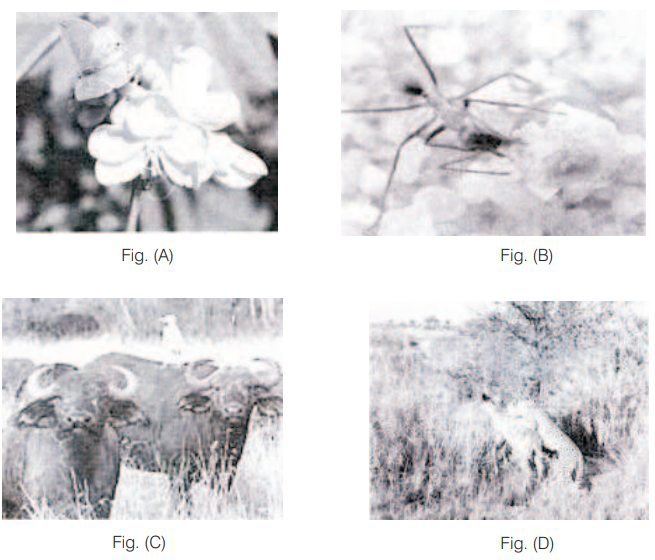$$ \text { Fill in the blanks } $$
| Species A | Species B | Type of Interaction | Example |
|---|---|---|---|
| + | - | __ | __ |
| + | + | __ | __ |
| + | __ | Commensalism | __ |
| Species A | Species B | Type of Interaction | Example |
|---|---|---|---|
| + | - | Predation | Phytophagous animal and plants. |
| + | + | Protocoperation | Oxpecker and black rhino |
| + | - | Comensalism | Sea anemone and Hermit crab |
Observe the set of 4 figures $\mathrm{A}, \mathrm{B}, \mathrm{C}$ and D and answer the following questions.
I. Which one of the figures shows mutualism?
II. What kind of association is shown in D?
III. Name the organisms and the association in C.
IV. What role is the insect performing in $B$ ?

I. Figure A show a pollinator (bee) on a flower. The association between pollinator insect and plant is termed as mutulalism.
II. Predation.
III. Egrets and grazing cattle is good example of commensalism.
IV. Scavenging- The insect is playing the role of an scavenger.
Comment on the following figure: I, II and III, A, B, C, D, G, P, Q, R, S are species.

Figure I It is a single population and all individuals are of the same species, i.e., a individuals interact among themselves and their environment intraspecific interaction.
Figure II It is a community and it contains three populations of species A, B and C. They interact with each other and their environment and is called interspecific interaction.
Figure III It is a biome. It contains three communities of which one is in climax and other two are in different stages of development. All three communities are in the same environment and they interact with each other and their environment.
An individual and a population has certain characteristics. Name these attributes with definitions.
An individual and a population has following certain attributes like pattern of distribution. dispersal biotic potential and gene pool. Phenomenon of distribution of individual within geographical boundaries of the population is termed as interapopulation dispersion or internal distribution patterns or dispersion.
Dispersal an individual is dispersed at one or another time during their life in a population which is revealed by immigration or emigration.
(i) Immigration is the number of individuals of the same species that have come into the habitat from elsewhere during a specified time period.
(ii) Emigration is the number of individuals of the population who exit or leave the habitat and go elsewhere during a specified time period.
Biotic Potential Biotic potential is the natural capacity of a population to increase its size under ideal environmental conditions.
Gene pool All the genotypes of all individuals in a breeding population is referred to as gene pool.
The following diagrams are the age pyramids of different populations. Comment on the status of these poulations.

Figure A It is a 'pyramid' shaped age pyramid. In this figure, the base, i.e., pre-reproductive stage is very large as compared with the reproductive and post-reproductive stages of the population. This type of age structure indicate that the population would increase rapidly.
Figure B It is an 'inverted bell' shaped pyramid. In this figure, the pre-reproductive and reproductive stages are same. This type of age structure indicates that the population is stable.
Figure C It is 'urn' shaped pyramid. In this figure, the pre-reproductive and reproductive stages are less than the post-reproductive stages of this population. In this population more older people are present. This type of age structure indicates that the population definitely is declining.